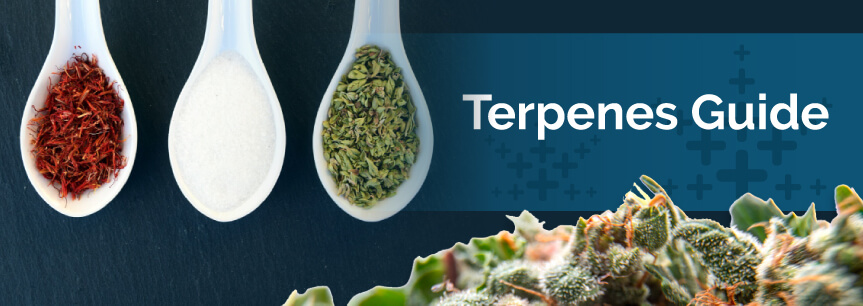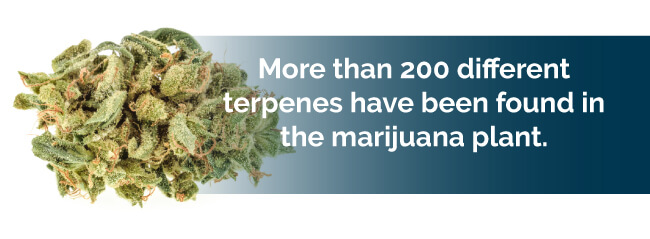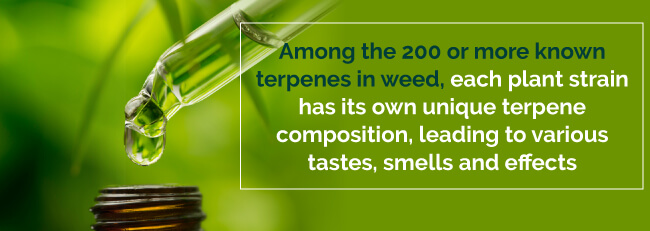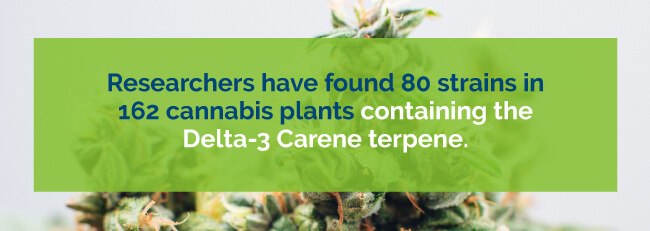
The marijuana plant contains an array of chemicals and compounds. Many are known as terpenes, which belong to a large group of aromatic organic hydrocarbons. Below is an in-depth guide on terpenes as they relate to marijuana, including their role and the main types.
You’ve likely heard of the word “turpentine,” and its distinctive piney smell. The word terpene is derived from the main ingredient in turpentine.
Terpenes are the fragrant oils that are secreted alongside CBD, THC and other cannabinoids. They’re the aroma that cannabis users know so well. They affect both the taste and aroma of your bud, and some terpenes are believed to have medicinal effects.

Without terpenes, marijuana would be bland. Cannabinoids, like THC, have little taste or odor. Terpenes are the pungent oils that give cannabis distinctive flavors like berry, pine, citrus and mint.
Much like with other strong-smelling flowers and plants, terpenes in marijuana evolved for adaptive purposes: to lure pollinators and repel predators.
There are a handful of factors that influence the terpene development of the plant, including:
Even the time of day can influence a plant’s terpene development. For instance, as a grower, you’ll find that the aroma is most often stronger at dawn than it is at dusk. Typically, the aroma of the cannabis plant is more intense during its flowering growing stage, but it can vary depending on fertilizers, weather and growing conditions. Generally speaking, a cannabis plant that has a minimal aroma will also have little flavor.
When grown using different fertilizers or in various soils, some strains can produce different profiles because of these variations.
More than 200 different terpenes have been found in the marijuana plant. Each cannabis strain offers a unique terpene composition and type. For instance, a strain of blueberry inherits a berry aroma, while lavender is sweet and floral.

Since there are more than 200 terpenes, there are practically limitless combinations. These endless possibilities of terpene combinations present variations in the effects, aroma and taste of marijuana.
You might have heard about terpenoids, which are compounds related to terpenes. The terms terpenoid and terpene are often used interchangeably, but they have different meanings. The main distinction between them is that terpenes are hydrocarbons, with the only components present being hydrogen and carbon. Terpenoids, on the other hand, have been dried and cured, and therefore chemically modified.
Terpenes are synthesized in weed inside glandular trichomes in secretory cells, and exposure to light increases production. Terpenes in cannabis are mostly found in unfertilized female marijuana flowers in high concentrations before their deterioration process.
Growers use steam distillation or vaporization to extract the essential oils from the plant. A lot of terpenes vaporize at much the same temperature as THC, although some are more volatile.
Terpenes ensure several functions. Plants use these aromatic compounds to attract the insects that pollinate flowers, thus ensuring reproduction. Terpenes also provide the cannabis plant with natural protection from insects, bacteria, fungus and other environmental stresses. Since plants can’t move to escape predators or flee when nearby plants begin overwhelming their territory, they have come up with an efficient defense system: terpenes.
Terpenes, like cannabinoids, bind to receptors in your brain and produce certain effects. Terpenes work in tandem to either inhibit or activate the effects of other compounds within the marijuana plant.
Because of variances in curing and growing techniques, different harvests may exhibit entirely unique terpenoid profiles. The only real way to know a strain’s terpene potency is through lab testing. However, you don’t need to be a botanist, marijuana grower or scientist to identify which terpene will produce your desired therapeutic effect. Your nose is highly effective at identifying terpenes.

One study shows medical cannabis strains can differ substantially among sources, and sometimes even between harvests. You can quickly identify certain strains by their smell when they have fairly high concentrations of certain terpenes.
For example, strains that smell like clove or musk tend to deliver relaxing, sedative effects (high myrcene terpene levels), strains that smell like lemon tend to produce an uplift in attitude and mood (high limonene terpene levels) and those with a piney smell tend to deliver memory retention and mental alertness (high pinene terpene levels).
Terpenoids are said to reduce THC-induced anxiety, immunosuppression and cholinergic deficit, but also enhance cortical activity, increase cerebral blood flow, provide anti-inflammatory activity and kill respiratory pathogens. They provide a wide range of biological properties, such as:
You’re likely familiar with marijuana being used as a recreational drug as well as a therapeutic remedy, but what you may not realize is the subtle aspect of it also being an aromatic plant. Think about the herbs in your kitchen. They’re considered to be aromatic plants, since they have a certain terpene profile that produces a distinctive flavor. Likewise, cannabis is a complex plant, and its potential terpene combinations are endless. These terpenes create a broad range of flavors and aromas in marijuana that can be used in aromatherapy.

Many terpenes in plants act in harmony with other terpenes, and some either activate other compounds in a plant or inhibit formation. For instance, scientists can manipulate cannabinoids into different desired ratios when they understand the role of different terpenes. Some terpenes balance the psychoactive and physiological effects of cannabis.
Furthermore, it turns out terpenes are just as healthy for people as they are for plants. In Dr. Ethan Russo’s 2011 report published in theBritish Journal of Pharmacology, he discussed the many therapeutic qualities of terpenoids that aren’t found in CBD-only products.
One terpenoid is beta-caryophyllene (BCP). Cannabis contains a significant amount of this BCP terpene, which contributes to the flavor and aroma. You find this terpene in other legal herbs, food plants and spices. For instance, it’s what contributes to black pepper’s spiciness. It also triggers CB2 receptors and behaves much like a non-psychoactive anti-inflammatory.
Jürg Gertsch, a Swiss scientist, documented BCP’s binding relationship with CB2 receptors in 2008 and called it a “dietary cannabinoid.” In fact, it’s the only terpenoid said to activate a cannabinoid receptor directly, and is one reason leafy green vegetables are so good for us.
Both cannabinoids and terpenoids increase blood flow, kill respiratory pathogens like MRSA (antibiotic-resistant bacteria) and enhance cortical activity. MRSA has claimed tens of thousands of American lives in recent years. In Dr. Russo’s report, cannabinoid-terpenoid interactions were named as being effective treatments for:
Terpenes are an essential element of your overall experience with cannabis. They not only influence the smell and taste of cannabis strains, but also have varying effects on your mind and body. You may have heard of the term “entourage effect,” which is the total effect of all cannabis components. This documented anomaly is what separates one strain from another, and it relies on terpene-produced physiological effects.
The FDA has recognized terpenes as being safe. They act on your neurotransmitters and receptors, and are likely to dissolve in or combine with fats or lipids. The terpenes in cannabis act as serotonin reuptake inhibitors (antidepressants like Prozac), increase dopamine activity, enhance norepinephrine activity (tricyclic antidepressants like Elavil) and augment gamma-aminobutyric acid. However, more research is needed to describe and predict exactly how cannabis terpenes may be used in treating certain health conditions.
Terpenoid profiles differ between strains, and affect not only the aroma and flavors of weed, but also influence their medicinal properties. They can either work together or act to inhibit the effects of cannabinoids.
For instance, some terpenoids dilate your lungs’ capillaries, making it easier for vaporized or smoked THC to enter your bloodstream. One terpenoid, nerolidol, is a sedative that penetrates your skin and sucks up topicals more quickly to help with pain and skin ailments. Ongoing research is being conducted to evaluate the value of terpenoids to treat health conditions such as the ones mentioned above.

Among the 200 or more known terpenes in weed, each plant strain has its own unique terpene composition, leading to various tastes, smells and effects in different strains. When doctors, patients, growers and recreational users know the terpene composition in a strain, they can test a sample to verify its identity.
The varied attraction of the different pot flavors is impressive enough. However, the most alluring characteristic of terpenes is their capability of interacting with other compounds in cannabis. Over the past several decades, most of the varieties of marijuana have been grown to contain high THC levels. Because of this, other cannabinoids like CBD are only found in trace amounts. This is what led many people to believe terpenes play a big part in distinguishing the various cannabis strain effects.
THC binds to cannabinoid receptors in your brain, where it produces the psychoactive effects. Some terpenes also affect the chemical output of these receptor sites. Others alter the amount of THC that passes through your blood-brain barrier. As mentioned, terpenes also influence neurotransmitters like serotonin and dopamine by modifying their production and destruction rate, their availability of receptors and their movement.
The effects produced vary among marijuana terpenes, with some promoting acuity and focus and others relieving stress.
Whether you’re a grower searching for a way to tailor a strain, a patient looking for therapeutic effects or a recreational user looking for a specific buzz, you can put terpenes to your advantage by learning about them. Below are 10 primary types of terpenes.
As its name suggests, limonene gives off a citrusy smell. Limonene has gained medical attention for its anti-carcinogenic properties. Limonene’s properties can be used as potential treatments such as:

Strains with high limonene levels include Lemon Diesel, OG Kush and Sour Diesel.
Myrcene is the most prevalent terpene in weed varieties. Its concentration is what makes a strain have either a Sativa or Indica effect. You get a more sedative high from strains that have more than 0.5 percent of myrcene. Strains with less than 0.5 percent myrcene produce an energizing effect.
The myrcene terpene is thought to work together with THC, increasing its psychoactive effects. Different strains that contain myrcene smell like cloves or give off a musky, earthy and sometimes tropical or citrus aroma. Its potential medicinal properties include:
High myrcene strains include Skunk1, El Nino, White Widow, Pure Kush and Himalayan Gold.
This terpene has a citrus, floral, sweet and lavender smell. It has tranquilizing effects and has been found to help those with psychosis. Its potential medicinal properties include:

Strains high in linalool include Lavender, G-13, LA Confidential and Amnesia Haze.
The caryophyllene terpene has a spicy, black pepper smell. It’s been said to selectively activate CB2 receptors, even though it’s not a cannabinoid. Because of this, researchers are studying its potential medicinal properties, including:
Strains with high levels of caryophyllene include Green Lantern and Hash Plant.
The alpha bisabolol terpene has a floral aroma and flavor. It’s also found in chamomile. Its potential medicinal properties include:
It can even be used as a deodorizer. The Oracle strain contains high levels of this terpene.
This terpene has a camphor and mint aroma and has been used in Chinese medicine. Its potential medicinal properties include:
Strains with borneol include K13 and Silver Haze.
The delta-3 carene terpene has an earthy or piney aroma and flavor. Studies have shown this terpene useful as an anti-inflammatory. It’s often used to treat excess bodily fluids, treat inflammation and repair bones.
Researchers have found 80 strains in 162 cannabis plants containing this terpene.

Like other cannabis terpenes, delta-3 carene is effective in treating an array of medical conditions due to its anti-inflammatory effect. Research studies and anecdotal evidence shows it promotes quick bone healing. It has potential to treat symptoms of conditions like osteoarthritis and osteoporosis, according to researchers.
Its anti-inflammatory qualities are most often used for treating:
When delta-3 carene is combined with other cannabinoids and terpenes, it is an effective part of an entire treatment plan for these and other common conditions and diseases.
The eucalyptol terpene smells like eucalyptus leaves, with only small levels found in weed. Its potential medicinal properties include:
Strains with this terpene include Super Silver Haze.
Nerolidol has a woodsy, fresh-bark aroma, with potential medicinal properties that include:
Strains with this terpene include Jean Guy.
As its name suggests, pinene has the distinct aroma of pine and fir. There are two structural compounds of pinene: alpha (a-pinene) and beta (b-pinene). Both forms are essential components of pine resin. Pinene is mostly found in pine woods, balsamic resin and citrus fruits. Its potential medicinal properties include:
Pinene has also been found to lessen the effects of THC.
Besides primary terpenes, 20 secondary terpenes come in substantial concentrations. Three secondary terpenes include:
Ocimene is an isomeric hydrocarbon. Many plants and fruits contain it, including cannabis. It’s known for its fragrant, sweet, woodsy and herbaceous aromas. Ocimene works as a defense system for plants in their natural environment. Its medicinal properties include:
Marijuana strains that have high levels of ocimene include Strawberry Cough, Golden Goat, Space Queen and Chernobyl.
Another isomeric hydrocarbon, terpinolene, is characterized by its floral, piney, herbal and fresh aroma. It’s sometimes citrusy and found in a variety of fragrant plants, including cannabis. Its medicinal properties include:

Terpinolene is typically found in Sativa strains. Strains high in this terpene include Jack Herer, Super Jack, Pineapple Jack and J1.
Guaiol is a sesquiterpenoid alcohol, not an oil. It’s found in guaiacum and cypress pine. Guaiol works effectively as an insect repellent. Its medicinal properties include:
Strains that have high levels of guaiol include Liberty Haze, Chocolope and Blue Kush.
Testing pot strains for terpenes is an evolving science. There’s still much to learn about terpenes and their benefits. Researchers will continue to extract and test them clinically.
As a marijuana consumer, your nose is helpful in detecting terpenes in strains. Your nose can only go so far, though. You need to chemically analyze cannabis to know what’s truly in it. Being able to analyze marijuana for its chemical profile allows growers to narrow down precisely and produce specific results. It also allows patients to know which strains will help with their symptoms and make them feel better and allow recreational users to look forward to certain characteristics.
How can you determine a strain’s chemical profile without the hassle and expense of lab testing? Tools like MyDx can help. This tool is a “portable lab” that uses both an analyzer and cannabis-specific sensor to detect cannabinoids and terpenes. When you’re able to track how a strain relieves your symptoms and make you feel, you can identify the best strains for your particular situation.
Terpenes and their effects make for a fascinating topic, and open up exploration by researchers, growers and the medical community to identify further beneficial applications.
As marijuana is becoming legal in more states for both medicinal and recreational purposes, research on strain-specific development will become more accessible. As people become more aware of the different types and effects of terpenes, medical dispensaries are starting to cater to specific requests.
Remember, terpenes and marijuana and their effects can vary among strains and harvests. Therefore, you can’t rely on old information when you buy your weed. Now, when you search for a medical cannabis dispensary or a doctor, you can now discuss the different terpenes found in different strains.